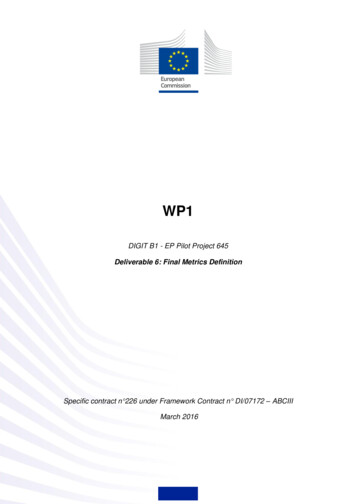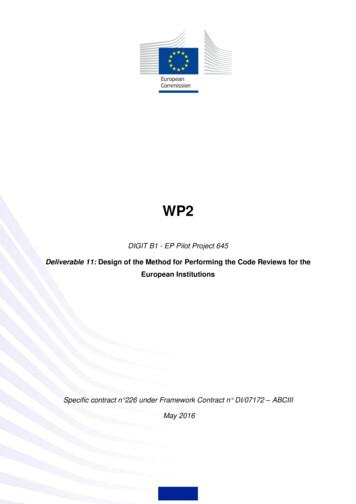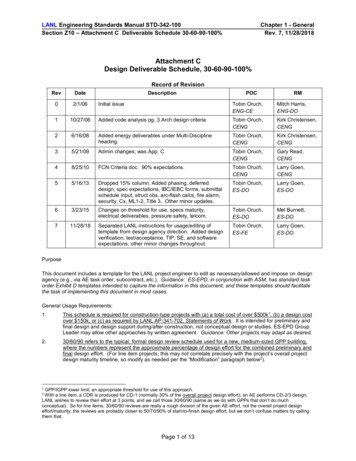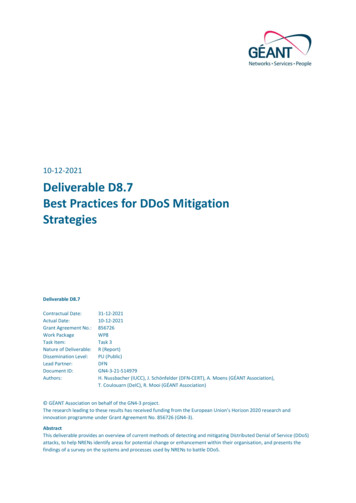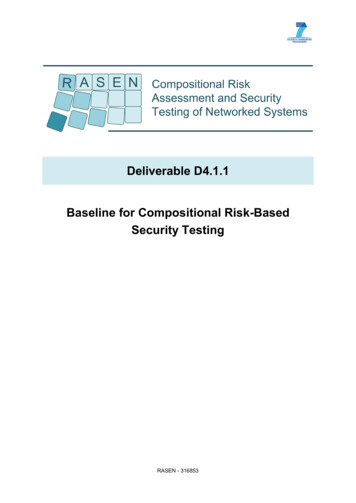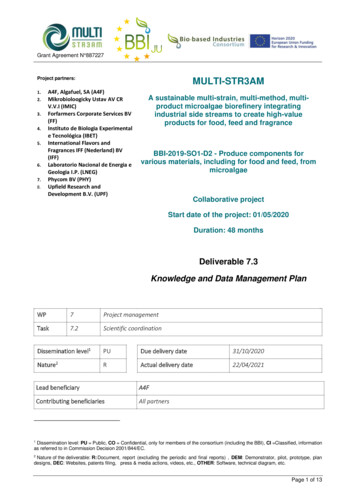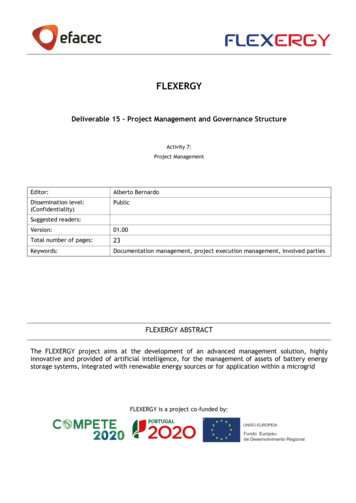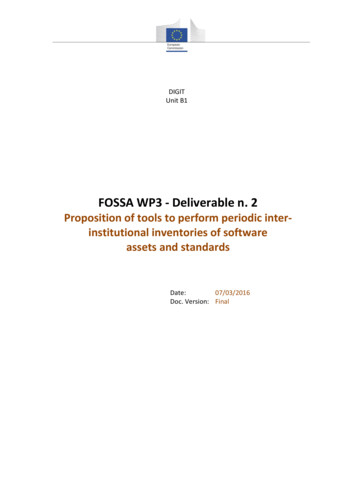
Transcription
DIGITUnit B1FOSSA WP3 - Deliverable n. 2Proposition of tools to perform periodic interinstitutional inventories of softwareassets and standardsDate:07/03/2016Doc. Version: Final
FOSSA WP3 Deliverable 2TABLE OF CONTENTSTABLE OF FIGURES . 3TABLE OF TABLES. 31. DELIVERABLE OVERVIEW . 42. OSS PILOT INVENTORY SCENARIOS . 52.1. Pilot Scenario - Main features and constraints. 52.2. Target Scenario – main features . 63. GENERAL INVENTORY PROCESS ARCHITECTURE (PILOT SCENARIO) . 73.1. Solution architecture . 73.2. Data management patterns . 84. OPEN SOURCE INVENTORY APPROACHES IN THE PILOT SCENARIO . 144.1. Step 1 - Software component inventory. 144.2. Step 1 - Standards inventory. 164.3. Step 2 - Metadata collection . 184.4. Step 3 - Data filtering and ranking . 205. TOOLS SELECTION IN THE PILOT SCENARIO. 215.1. Approach and selection criteria . 215.1.1. Selection criteria . 215.2. Longlists of tools . 215.3. Shortlists of tools . 226. TOOLS SCORING AND RANKING IN THE PILOT SCENARIO . 236.1. Scoring / ranking criteria . 236.2. Scoring and ranking of ETL tools . 266.3. Scoring and ranking of CMDB tools . 296.4. Relational databases . 316.5. Scoring and ranking of Business Intelligence tools . 326.6. Summary of tool ranking . 347. TARGET SCENARIO – OVERVIEW OF POSSIBLE ARCHITECTURE AND APPLICABLETOOLS . 357.1. Guidelines for the evolution towards a Target Scenario . 357.2. Overview and first assessment of integrated tools for software portfoliomanagement . 358. APPENDIX 1 – RATIONALES FOR THE DEFINITION OF TDM ENTITIES FEEDINGPATTERNS . 389. APPENDIX 2 – SOURCES FOR THE IDENTIFICATION OF ETL TOOLS FEATURES . 4210. APPENDIX 3 – SOURCES FOR THE IDENTIFICATION OF CMDB TOOLS FEATURES. 4311. APPENDIX 4 – SOURCES FOR THE IDENTIFICATION OF BI TOOLS FEATURES . 4312. APPENDIX 5 – ABBREVIATIONS AND ACRONYMS . 43Date: 07/03/20162 / 43Doc.Version: Draft
FOSSA WP3 Deliverable 2TABLE OF FIGURESFigure 1 - Pilot and target scenario . 5Figure 2 - Solution Architecture . 8Figure 3 - Synthetic representation of TDM entities feeding patterns . 13Figure 4 - Families of tools for the execution of software components inventory in the variousapproaches. 16Figure 5 - Families of tools for the execution of software components inventory – possibleevolution towards a target scenario . 35TABLE OF TABLESTable 1 - Manual effort estimation . 9Table 2 - Feeding pattern evaluation variables . 10Table 3 - Analysis of possible feeding patterns by TDM entity . 11Table 4 - Analysis of possible Software components inventory approaches . 15Table 5 - Analysis of possible Standards inventory approaches . 17Table 6 - Analysis of possible Metadata collection approaches . 19Table 7 - Analysis of possible data filtering and ranking approaches. 20Table 8 - Scoring and Ranking Criteria (SRC). 23Table 9 - Community Activity sub-criteria and rating . 24Table 10 - Support sub-criteria and rating . 24Table 11 - Technology sub-criteria and rating . 25Table 12 – Features of Shortlisted ETL tools. 26Table 13 - Scoring of shortlisted ETL tools . 27Table 14 - Ranking of shortlisted ETL tools . 28Table 15 - Features of shortlisted CMDB tools . 29Table 16 - Scoring of shortlisted CMDB tools . 30Table 17 - Ranking of shortlisted CMDB tools . 31Table 18 - Features of shortlisted Business Intelligence tools . 32Table 19 - Scoring of shortlisted Business Intelligence tools . 33Table 20 - Ranking of shortlisted Business Intelligence tools . 34Table 21 - Summary of tool ranking by layer . 34Table 22 - First scoring of integrated tools for software portfolio management . 36Date: 07/03/20163 / 43Doc. Version: Draft
FOSSA WP3 Deliverable 21. DELIVERABLE OVERVIEWThe main aim of this deliverable is to accomplish the objective of “Task 2: Propose tools toperform periodic inter-institutional inventories of software assets and standards” of theFOSSA Pilot Project, which is to prepare a list, together with necessary justifications, of toolswhich can be used to keep and consolidate an inventory of software assets and standards,targeting regular automatic collection of data from systems existing in the EuropeanCommission and the European Parliament.The list also contains information necessary to support the subsequent selection of inventorytools by the European Commission and the European Parliament.This study briefly recalls (Section 2) the main features and constraints of the Pilot Scenario,comparing it with a Target Scenario, as already described in Deliverable 1 of Work Package 3(WP3-DLV1) of the FOSSA Pilot Project. This is done to clarify how the features and constraintsof the Pilot Scenario impact on the choice of the families of tools for the inventory process,and how easing some of such constraints in a Target Scenario may lead to a different approachto the selection of tools.Subsequently (Section 3), the general architecture of the inventory process and its layers areshown, together with its successive steps (the inventory of software components andstandards, the collection of pertinent metadata, the filtering and ranking of the data obtainedin the previous two steps). In particular, the architecture is put in relation with the TargetData Model (TDM) described in WP3-DLV1. This will help to recommend the manual or theautomatic management of information for each entity of the TDM, and therefore to identifywhere and how to use pertinent families of tools.In Section 4, for each of the three inventory steps mentioned above, the applicableapproaches are described and evaluated vis-à-vis the recommendations provided in Section3. This in order to identify the most appropriate approach to executing each of such steps,including the applicable families of tools.Section 5 describes how, for each family of tools to be used in the various layers of thearchitecture and steps of the inventory process, recommended tools are identified. This startsfrom a long list of potential candidate tools, filtered through appropriate selection criteria inorder to obtain a shortlist that is submitted to a detailed scoring and ranking based on furtherspecific criteria.Section 6 deals in fact with such scoring and ranking. The output of this section is thereforethe ranking of tools for each step and layer of the inventory process and architecture. As anoutput, it provides the European Institutions with a sound recommendation for the selectionof tools to execute of the software and standard inventories in WP4 and WP5 of the FOSSAProject.Finally, Section 7 provides a perspective view to this task, with a highlight of how the TargetScenario described in section 2 may impact on the choice of a wider range of tools for theexecution of the inventory. A list of tools that may be applicable to such Target Scenario issubmitted to a first tentative process of selection, scoring and ranking as described in Sections5 and 6.Date: 07/03/20164 / 43Doc. Version: Draft
FOSSA WP3 Deliverable 22. OSS PILOT INVENTORY SCENARIOSAs already described in Work Package 3, Deliverable 1 (WP3-DLV1) of the FOSSA Pilot Project, basedon the information collected during the interviews and the assessment phase, the execution of theOSS Inventory should be analysed under two different scenarios, represented in Figure 1 andexplained in the next paragraphs.Each of the two scenarios shortly describes the features and constraints of the inventory process forits three main steps: Software components and Standards inventory, Metadata collection, Filteringand ranking.Figure 1 - Pilot and target nario2.1. Pilot Scenario - Main features and constraintsThe Pilot Scenario described in WP3-DLV1, “Open Source Software Inventory Methodology”, andhighlighted in the picture above, is briefly recalled here in order to point out the impact that itsfeatures and constraints have on the choice of the inventory tools, as it will be detailed in section 3.Date: 07/03/20165 / 43Doc. Version: Draft
FOSSA WP3 Deliverable 2One major constraint, in the framework of the Pilot project, is the lack of authorization to install anynew agent to autonomously retrieve the data needed for the Inventory.Consequently, the data must be collected by requesting (and obtaining) flat files (.csv) from the datasources identified during the interviews (e.g. AppV, Landesk, Satellite ). All such data sources havedifferent Data Models, with information on the same domain that could be fragmented throughdifferent data sources; this determines a strong need to properly elaborate and integrate thedifferent collected files.Such files are provided by the data owner by an on-demand ("pull") approach starting from requestsset by the coordinator of the inventory process (or “Inventory Manager”). However, the nonautomatic, voluntary nature of such flow does not provide any guarantee on the exact timing andfinal format of data that would be effectively provided.An additional relevant data quality issue is that the information currently made available by theEuropean Commission and the European Parliament only partially covers the minimum set ofinformation identified by Target Data Model (TDM). In the Pilot Scenario, therefore, the informationcontent of the TDM will be partial, due to the lack of data sources. In particular, the information onthe "Standard" entity, identified as core (see section 3.3 below), is limited. It may be thereforenecessary to cross-check such information with external sources (e.g. through web crawling).2.2. Target Scenario – main featuresAs for the study on the inventory methodology, a Target Scenario has been considered, in order toidentify guidelines for the possible evolution of the OSS inventory activities to a more streamlinedprocess, which may also impact on the choice of tools to perform it. This would be obtained mainlyby easing some of the constraints pointed out for the Pilot scenario.First of all, the access to wider, more complete information sources, in line with the requirementsset by the Inventory Manager, must be granted to industrialise and automatize the Inventoryprocess, so to ensure the completeness of the inventory and Target Data Model feeding.In particular, the information must be complete with regard to the criticality assessment criteria andto the core entities of the TDM defined for the inventory.Additionally, the required information must be easily and quickly accessible, and a scheduled("push") approach must be enabled; this approach should be automated to grant persistentefficiency.It must be underlined that, even in this Target Scenario, the constraints of the Pilot Scenario in termsof access to servers have been still considered applicable. However, the scenario and thearchitecture resulting from it may change if such constraints are removed, allowing the use of furtherfully integrated tools, that shall be shortly described at the end of the present study.Date: 07/03/20166 / 43Doc. Version: Draft
FOSSA WP3 Deliverable 23. GENERAL INVENTORY PROCESS ARCHITECTURE (PILOT SCENARIO)In the following paragraphs we are going to describe in detail: The various technical components that will implement the solution, organized in layers; The data management patterns, describing how the various entities in the Target Data Modelwill be managed and fed with the pertinent information.The architecture described below relies on families of tools, within which the candidate tools for theexecution of the Pilot inventory will be selected.3.1. Solution architectureBased on the features and constraints of the pilot scenario, the technical solution for a federatedCDMB is composed by the following layers, from the upper to the lower: Presentation layer: the user-facing part of the solution, composed of the following mainmodules: Reporting; Data Navigation (OLAP); Local Data Management; DBMS: the Data Base engine that will store the data of interest, either coming from externalsystems or locally managed by the user; ETL Tool: the system or component that will perform the filtering, transformation andloading in the target data model of the data loaded in the staging area; this system shouldprovide facilities for data lookup, encoding and data processing; Feeding files: these files, coming from the various asset inventory tools currently in use, willprovide the information about the installed software base in the system in use. All files willbe stored in the Staging area of the Target Data Base for further processing. The originatingsystems are not in scope and no further software components are needed.Date: 07/03/20167 / 43Doc. Version: Draft
FOSSA WP3 Deliverable 2Figure 2 - Solution Architecture3.2. Data management patternsIn the architecture described above, two distinct feeding patterns of the mapped data into therepository are possible: Manual – Locally managed by the end users: the data will be locally managed by an ad-hocuser interface (local data management module) mapping the data content of the variousentities; Automatic – Feeding files loaded from external systems/sources using an ETL Tool; therequired data will be provided in the form of file extractions (.csv or other).The feeding pattern of a certain entity may change with time, depending on the maturity of thesolution. For example, the information on "Software Rating" may be fed manually in the frameworkof the Pilot Project, while at a later stage it could be integrated automatically with a software qualityinspection tool.For each entity of the data model, the feeding pattern is defined by applying the following criteria:1. Estimated effort to manually populate the entity; this parameter is function of: the frequency of update of the related information; The volume of input data.2. Type of data source (e.g. structured, unstructured).Date: 07/03/20168 / 43Doc. Version: Draft
FOSSA WP3 Deliverable 2In order to determine the best feeding pattern of each entity of the TDM, an opportunity assessmentis made by using the following two variables:A. Estimated effort to manually populate the entity. This estimation is based on two more variables:--the frequency of update, with two possible values: Low: the information is stable over a long time span (monthly or higher): e.g. list oflicenses, list of standards; High: the frequency with which the information changes is high (weekly/daily): e.g. listof installed software;The volume of input data to load, with two possible values: Low: less than 100 instances; High: more than 100 instances.This variable is attributed the following range of values, computed by combining the subvariables described above in the scoring table below:-Low effort: less than a man-day, for low frequency / low volume data-Medium effort: from one to five man-days, for low frequency / high volume or highvolume / low frequency data-High effort: more than five man-days, for high volume / high frequency dataTable 1 - Manual effort MediumHighUpdateFrequencyMediumHighB. Type of data source, with three possible values:-Unstructured: the information in the source is not structured, so it is not possible to build aparser to create a flat file to feed the CMDB: e.g. Software documentation, Standards;-Structured, easy to get: the data is available in a structured format, either from internal ECsystems (e.g. list of installed Software), or from external systems/repositories (xml metadatafor Software, when available);-Structured, hard to get: data that are structured but require building a custom tool in orderto produce an input file, (e.g. Community support), or from a structured file, like Softwaredependencies.Once the two above variables (Estimated Effort and Data Source Type) are computed for each entityof the TDM, the choice of feeding pattern is made by crossing them in a table, which provides thefollowing values:Date: 07/03/20169 / 43Doc. Version: Draft
FOSSA WP3 Deliverable 2 Manual: when the data source is unstructured or data is hard to get and effort is low; Automatic: when data is structured; By opportunity: if the data is hard to get and estimated effort to collect them is medium to high,a cost/benefit analysis should be performed, in order to evaluate the complexity of buildingfeeding tools and/or acquiring the proper data from external sources. Such analysis, based onthe possible data sources, may be performed through a list of possible extraction tools,presented in Table 3, which can be built to support the extraction.Table 2 - Feeding pattern evaluation , easyto getAutomaticAutomaticAutomaticStructured, hardto ualUnstructuredThe result of the evaluation made by applying the above variables to each entity of the TDM ispresented in Table 3 below. Such table also provides a list of possible tools that can be built to extractdata from external sources. Further detail on the rationales used to attribute a certain value to thevariables described above is provided in Appendix 1. .Date: 07/03/201610 / 43Doc. Version: Draft
FOSSA WP3 Deliverable 2Table 3 - Analysis of possible feeding patterns by TDM entityEntityAvailable data sourcesSoftwareList of installed software Names need to befrom EC CMDB systems normalized in order tomatch incomingmetadata from externalsources (e.g. frompackage name to project/ software name)List of installed software Versions need to befrom EC CMDB systems normalized in order tomatch incomingmetadata from externalsources (e.g. frompackage version toproject / softwareversion) DIGIT reference list of Organized into astandards refreshed semantic treeSoftwareVersionStandardTransformationmapping SystemDate: 07/03/2016Specialized sites (e.g.ISO, W3C, ANSI, OMGetc.)List of installed software Straight loadingfrom EC CMDB systems (ifavailable)11 / 43/UpdateFrequencyDataVolumeEffortData Source Feeding patterntypeLowHighMediumStructured,easy to getAutomaticn/aHighHighHighStructured,easy to ghMediumStructured,easy to getAutomaticn/aDoc. Version: DraftCustom builtExtraction Tool
FOSSA WP3 Deliverable 2EntityAvailable data sourcesTransformationmappingOrganization List of how producersfrom CMDB systemfor HW Organizationsmanaging softwarefrom externalmetadata EC organizationmanaging systemsfrom Org chartSpecialized sites (i.e.OpenHub)Publicly availablevulnerability sources (e.g.NVD)Specialized sites (e.g.OpenHub) Specialized sites (e.g.OpenHub)Defined by themethodologyList of installed softwarefrom EC CMDB systemsList of installed softwarefrom EC CMDB systemsPublicly availablevulnerability sources(e.g.NVD)Package dependenciesfrom softwaredistributionsMapping from SW to listof eCriteriaSoftwareVulnerabilitiesDependenciesDate: 07/03/2016 /Normalized data forHW producersNormalized data forsoftwaredevelopment entitiesStraight loading forEC managementorganizationsnoneConversion from sourcemessageMapping from specializedweb sitesMapping from SWversion to list of systemsMapping from SWversion to list of systemsNoneMapping from packagesversion to softwareversions12 / 43UpdateFrequencyDataVolumeEffortData Source Feeding ult to getBy opportunityCustom builtExtraction ToolIntegration with mailboxWeb page scrapingtoolBy opportunitypartial coverage bystandard typeStructured,Web page scrapingMediumBy opportunitydifficult to gettoolStructured,Mediumdifficult to hHighHighStructured,easy to ighHighStructured,Integration with mailBy opportunitydifficult to getbox ETL toolLowHighMediumStructured,Parsers for packageBy opportunitydifficult to getdependenciesDoc. Version: Draft
FOSSA WP3 Deliverable 2Based on Table 3, the following image shows in a synthetic way the feeding approach for the variousentities of the TDM.Figure 3 - Synthetic representation of TDM entities feeding patternsThis fragmented scenario for the data collection can be enhanced by leveraging on two drivers:1) Improve the quality of data sources, moving to structured and easy-to-access data sources(i.e. pay a data provider or buy commercial solutions).2) Build / Acquire data collection tools for the different data sources required for thecompletion of the TDM.Date: 07/03/201613 / 43Doc. Version: Draft
FOSSA WP3 Deliverable 24. OPEN SOURCE INVENTORY APPROACHES IN THE PILOT SCENARIOIn the framework of this study, several approaches to the collection of data for the core entities ofthe TDM have been considered and evaluated as per the criteria set forth in section 3 above. Theapproaches considered are only those realistically applicable to the Pilot Scenario, i.e. under theconstraints described in paragraph 2.1.In the following paragraphs, we describe the approaches identified for the three steps of theinventory process described in Section 2 (Software component inventory and Standard Inventory,Metadata Collection, Filtering and Ranking).4.1. Step 1 - Software component inventoryUpon the outcome of the interviews and the assessment phase, the following possible approachesto the execution of Step 1 (Software component Inventory) of the OSS Inventory approach havebeen identified.Date: 07/03/201614 / 43Doc. Version: Draft
FOSSA WP3 Deliverable 2Table 4 - Analysis of possible Software components inventory approachesAPPROACHDESCRIPTIONINTEGRATION, REUSABILITY AND EFFORT ANALYSISA – ManualloadingGet the various information/data sources and load them manuallyinto a single Personal Productivity System file. Each step is local inrelation to the Inventory tool:1. Get input files from Landesk, App-V, Satellite ;2. Manually integrate the files;3. Store information into a Personal Productivity System file(e.g. OpenOffice);4. Visualise through reports or via spreadsheets graphics.Level of integration: Low. Only desktop tools and manualtasks.Level of reusability: Low. Several manual steps to repeat oradaptImplementation effort: Low. No development.Operations effort: Very High. Crunching the data manuallywould be very time consumingB – Integrateinto a localdatabaseIntegrate the available information/data sources into a Localdatabase:1. Get input files from Landesk, App-V, Satellite 2. Integrate the files through an ETL tool, working as a bridgebetween sources and the Inventory tool;3. Store information into a database (MySQL, PostgreSQL,etc.) local to the Inventory tool;4. Visualise via Business Intelligence tools local to theInventory tool.Level of integration: Medium. Server based DBMS issuggested, along with Business Intelligence and ETL tools.However, the inventory platform does not rely on a CMDB.Level of reusability: Medium. The inventory platform can bemigrated towards a CMDB in the future using an ETL tool.Implementation effort: Medium. The number of toolsinvolved in this stack is moderate.Operations effort: Low. Building the inventory once theplatform is ready will be mostly automated.C – Integratedirectly on aCMDB toolIntegrate the available information/data sources directly on aCMDB tool:1. Directly integrate input files from Landesk, App-V, Satelliteand other data sources into a target CMDB tool:a. Through a CMDB-native ETL tool, orb. Through an external ETL tool2. Visualise data directly from inside the CMDB tool.Level of integration: High. Specific solutions dedicated to ITasset management are used.Level of reusability: High. A CMDB tool already implementsstandards and best practices in the asset management field.Implementation effort: High. A CMDB tool can becomplicated to set up and manage.Operation effort: Low. These tools (ETL, CMDB) would allowmaximum level of automation.Date: 07/03/201615 / 43Doc. Version: Draft
FOSSA WP3 Deliverable 2The following figure describes the possible families of tools to implement each layer of the solutionarchitecture, comparing the three approaches described above, for the execution of the SoftwareComponent Inventory.Figure 4 - Families of tools for the execution of software components inventory in the variousapproachesPresentationDBMSETLFeeding filesApproach AApproach BApproach CSpreadsheetdiagramsBI toolIntegrated inventoryplatformDesktop DBMSDB serverDB serverManual operationDedicated ETL toolDedicated ETL tooland/orCMDB-native ETLCSV hostedin Git repoCSV hostedin Git repoCSV hostedin Git repoBased on the considerations of Section 3 (see Table 3, entities “Software”, “Software Version” and“Software Instance”), and on the constraints of the Pilot scenario, Approach “B” of Table 4 isrecommended for the execution of this step of the Pilot inventory. Approach “C” may be consideredin a target perspective. The pertinent families of tools shown in Figure 4 will therefore be analysedmore in detail in the following sections 5 and 6.4.2. Step 1 - Standards inventoryThe interviews and the assessment phase have led to the following considerations related to thenature of the data for the collection of Standards: data sources pertinent to standards are heterogeneous and currently only partially known; data are mostly unstructured.These assumptions have led to the conclusion of the necessity to manually collect and feed into theSolution the information pertinent to standards, integrating the information available from sourcesof the European Institutions with further publicly available information. A detailed analysis of therationale for this approach is shown in Table 5 below.Date: 07/03/201616 / 43Doc. Version: Draft
FOSSA WP3 Deliverable 2Table 5 - Analysis of possible Standards inventory approachesAPPRO
The Pilot Scenario described in WP3-DLV1, "Open Source Software Inventory Methodology", and highlighted in the picture above, is briefly recalled here in order to point out the impact that its features and constraints have on the choice of the inventory tools, as it will be detailed in section 3. "Pilot scenario" Scenario "Target" Scenario
